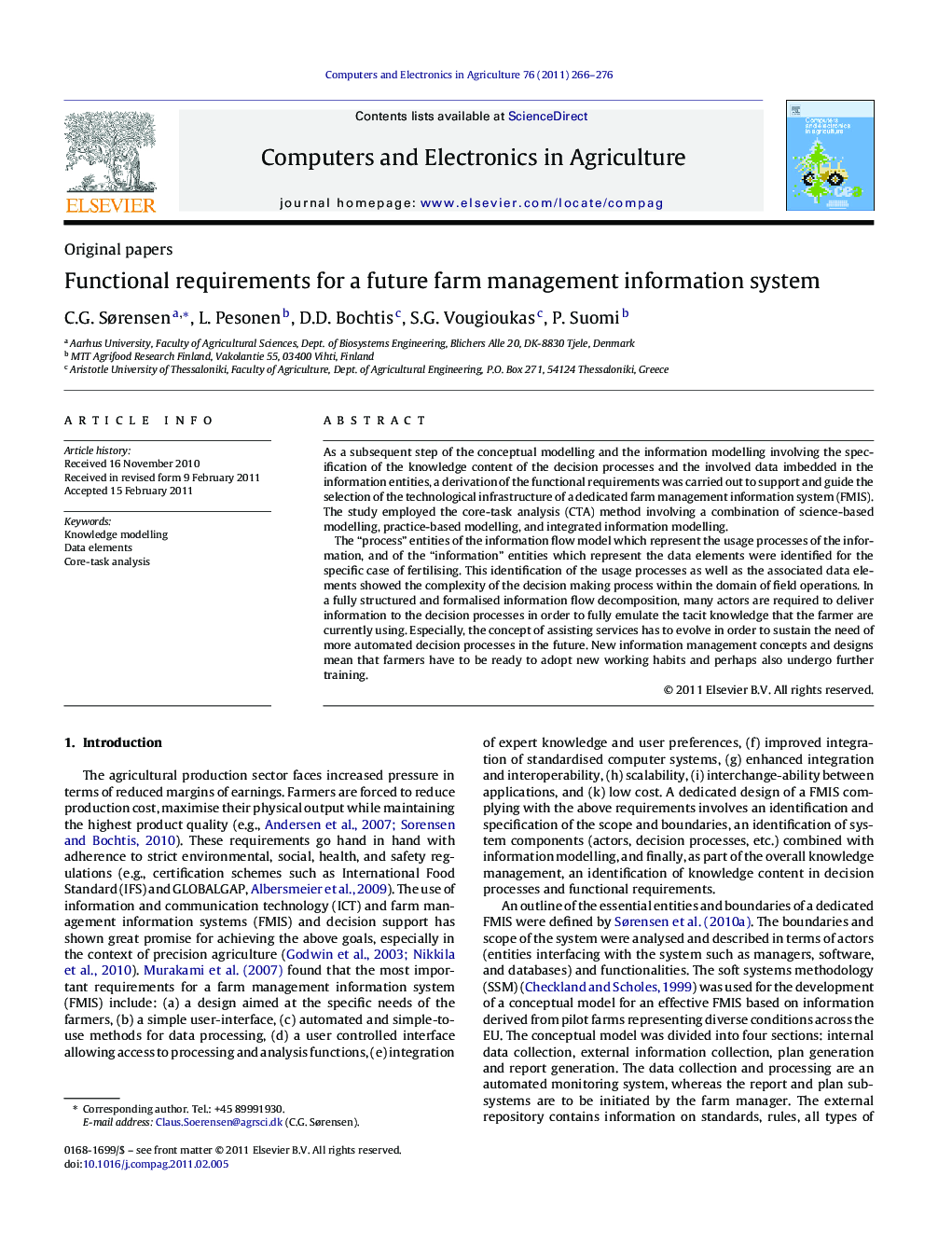| کد مقاله | کد نشریه | سال انتشار | مقاله انگلیسی | نسخه تمام متن |
|---|---|---|---|---|
| 84653 | 158895 | 2011 | 11 صفحه PDF | دانلود رایگان |
عنوان انگلیسی مقاله ISI
Functional requirements for a future farm management information system
ترجمه فارسی عنوان
الزامات عملکردی برای سیستم اطلاعات مدیریت مزرعه در آینده
همین الان دانلود کنید
دانلود مقاله ISI انگلیسی
رایگان برای ایرانیان
کلمات کلیدی
مدل سازی دانش - عناصر داده ها - تجزیه و تحلیل هسته کار -
فهرست مطالب مقاله
چکیده
مقدمه
نمودار: رویه مدل سازی و تحلیل
روش پژوهش
جدول 1 : توضیح فرایند تصمیم سازی
نتایجمدلسازی دانش
فرایندهای تصمیم گیری
ویژگیهای داده
نیازمندی های عملکردی و تصمیم گیری یاری شده
جدول 2 : تشریح داده ها برای سطوع اجراییبحث در مورد نتایج
نمودار: تصمیم گیری (تصمیم سازی) نتیجه گیری
مقدمه
نمودار: رویه مدل سازی و تحلیل
روش پژوهش
جدول 1 : توضیح فرایند تصمیم سازی
نتایجمدلسازی دانش
فرایندهای تصمیم گیری
ویژگیهای داده
نیازمندی های عملکردی و تصمیم گیری یاری شده
جدول 2 : تشریح داده ها برای سطوع اجراییبحث در مورد نتایج
نمودار: تصمیم گیری (تصمیم سازی) نتیجه گیری
ترجمه چکیده
به عنوان گامی فراتر در زمینۀ مدل سازی مفهومی و اطلاعاتی، که شامل مشخصه های محتوای دانش فرایندهای تصمیم گیری و شامل اطلاعات تعبیه شده در موجودیت های اطلاعاتی می شود، اشتقاقی از الزامات عملکردی به اجرا درآمد که با هدف حمایت و راهنمایی انتخاب زیرساختهای فنآوری سیستم اختصاصی اطلاعات مدیریت مزرعه (FMIS) اجرا شد. در این تحقیق از روش تحلیل وظیفۀ مرکزی (CTA) استفاده شد که شامل ترکیبی از مدلسازی بر پایۀ علم، مدلسازی بر پایۀ عمل، و مدلسازی اطلاعات یکپارچه است.
موجودیتهای "فرایندی" مدل جریان اطلاعات که نمایانگر فرایند استفاده از اطلاعات است و نهادهای "اطلاعاتی" که نمایندۀ عناصر داده ای هستند را برای مورد خاص باروری شناسایی کردیم. این شناسایی فرایندهای استفاده همانند عناصر داده ای مرتبط، نشان دهندۀ پیچیدگی فرایند تصمیم گیری در دامنۀ عملیات میدانی است.
در تجزیۀ رسمی و کاملاً ساختار یافتۀ جریان اطلاعات، عوامل متعددی لازم است تا اطلاعات را به فرایندهای تصمیم گیری برسانیم و بتوانیم شبیه سازی کاملی از دانش درونیای که کشاورز در حال حاضر به کار می گیرد را به دست آوریم. بویژه، باید مفهوم خدمات یاری رسان را تکامل بخشید تا در آینده فرایندهای تصمیم گیری خودکار تری را به دست آورده و حفظ کنیم. مفاهیم و طراحی های جدید در مدیریت اطلاعات به این معنی است که کشاورز باید آمادۀ اتخاذ عادتهای کاری جدید و یا شاید دریافت آموزشهای جدید باشد.
موضوعات مرتبط
مهندسی و علوم پایه
مهندسی کامپیوتر
نرم افزارهای علوم کامپیوتر
چکیده انگلیسی
As a subsequent step of the conceptual modelling and the information modelling involving the specification of the knowledge content of the decision processes and the involved data imbedded in the information entities, a derivation of the functional requirements was carried out to support and guide the selection of the technological infrastructure of a dedicated farm management information system (FMIS). The study employed the core-task analysis (CTA) method involving a combination of science-based modelling, practice-based modelling, and integrated information modelling.
The “process” entities of the information flow model which represent the usage processes of the information, and of the “information” entities which represent the data elements were identified for the specific case of fertilising. This identification of the usage processes as well as the associated data elements showed the complexity of the decision making process within the domain of field operations. In a fully structured and formalised information flow decomposition, many actors are required to deliver information to the decision processes in order to fully emulate the tacit knowledge that the farmer are currently using. Especially, the concept of assisting services has to evolve in order to sustain the need of more automated decision processes in the future. New information management concepts and designs mean that farmers have to be ready to adopt new working habits and perhaps also undergo further training.
ناشر
Database: Elsevier - ScienceDirect (ساینس دایرکت)
Journal: Computers and Electronics in Agriculture - Volume 76, Issue 2, May 2011, Pages 266–276
Journal: Computers and Electronics in Agriculture - Volume 76, Issue 2, May 2011, Pages 266–276
نویسندگان
C.G. Sørensen, L. Pesonen, D.D. Bochtis, S.G. Vougioukas, P. Suomi,
